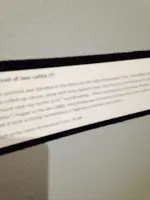Girard, Lallemand, Grouci, and Joseph Bonaparte were all deeply involved with Champ de Asile, the site of "their" Texas settlement having already been selected prior to their arrival at Galveston Island. It was Laffitte who had arranged their transportation from New Orleans to Galveston Island. It's also been suggested, based on some continuing research, that a second site for a fort had also been selected and possibly even prepared.
@ bigscoop,
You have been interested in Laffite long before I posted the Maison Rouge home site photos, so I thought you might be interested in this minor lost footnote in history, I certainly never heard of it before….. :
I was at the Rosenberg Library in Galveston today researching the building permit for a corner store / apartment building that the Historical foundation has expressed interest in purchasing from me.
They keep old records there and its halls serve as a museum of Galveston history.
In about 1880 John Sealy, one of Galveston's leading early business men (He later donated a large portion of his fortune in establishing the University of Texas John Sealy medical center,) broke ground for his home at about 25th street and Broadway in Galveston.
Today that home serves as a museum of sorts and has been completely rehabbed.
Its on petty high ground as far as the Island goes,and that may be one of the reasons he chose that particular location.
While breaking ground workmen reported finding a tin with the attached rolled up oil painting and also "a few spanish coins" in the same tin.
They turned the oil painting over to their customer, Mr Sealy and told him that they found it with a few spanish coins in "a tin" that was never addressed. That tin does not exist today, neither do the "few spanish coins".
Mr Sealy restored the painting and determined that it was of Jeane Lafitte, because it resembled his few classic portraits that are known to exist.
It certainly looks a lot like Lafittes existing portraits.
Mr Sealy ultimately framed and hung it in his newly built palatial Estate.
He later donated it to the Rosenburg library where it still hangs today.
The second photo is of the caption that explains the oil painting, but it just doesn't photograph well.
I basically described what it communicates in the paragraph I just wrote above.
The above described circumstance is absolute fact and it describes the origin of the oil painting that hangs in the Rosenberg Library today.
The sealy mansion lies on a relatively high spot on the island, but certainly not the highest.
This not too obvious, but relatively easy to find location is where Lafitte would have left something behind to reteave later,
If this is the case, Lafitte may very well have left the portrait of himself as proof that the cashe was originally his.
If he did bury riches under the site of the current Sealy mansion he may have recovered them later and left his likeness as a momento to whomever might come across it later.
It seems as a relatively ego driven individuals probable course of action.
The other explanation is, that on a spring day in the year 1880, a group of laborrors or Mr Sealy himself came across a buried cash of spanish treasure and simply did not report it.
Sealy went on to be one of the richest men in the United states at that time.
What do you think?
I haven't figured out how to add photo's to a reply
It seems easy enough when starting a thread.
Ill post the oil painting and the caption when I can...



 .....but ECS is absolutely right. Treasure "legends" abound everywhere and they seldom have any substance to the tale.
.....but ECS is absolutely right. Treasure "legends" abound everywhere and they seldom have any substance to the tale. And I do agree that he was an opportunist operating on the fringes of the New World that was taking shape all around the globe, especially here in the U.S. I don't know that I would say he was brutal, one has to remember that during his era the law carried an entirely different face depending on where it was enforced. Can you imagine dueling still being legal today, one could hardly take a quick trip to the corner store without seeing two all too proud men preparing to square off. There is also a lot of evidence suggesting that Laffitte and his agenda may have actually been utilized, or manipulated, by the U.S. in an effort to keep the political pressure on Spain in regards to the disputed territory, or "the neutral zone", that was established between the U.S. and Spain prior to the Adams Onis Treaty. Personally, from everything I have seen and researched, I think this is probably the case. However, in the end Laffitte was never able to fulfill his own agenda, just allowed to believe he might until he was no longer needed. There's actually quite a bit of evidence suggesting this.
And I do agree that he was an opportunist operating on the fringes of the New World that was taking shape all around the globe, especially here in the U.S. I don't know that I would say he was brutal, one has to remember that during his era the law carried an entirely different face depending on where it was enforced. Can you imagine dueling still being legal today, one could hardly take a quick trip to the corner store without seeing two all too proud men preparing to square off. There is also a lot of evidence suggesting that Laffitte and his agenda may have actually been utilized, or manipulated, by the U.S. in an effort to keep the political pressure on Spain in regards to the disputed territory, or "the neutral zone", that was established between the U.S. and Spain prior to the Adams Onis Treaty. Personally, from everything I have seen and researched, I think this is probably the case. However, in the end Laffitte was never able to fulfill his own agenda, just allowed to believe he might until he was no longer needed. There's actually quite a bit of evidence suggesting this.



